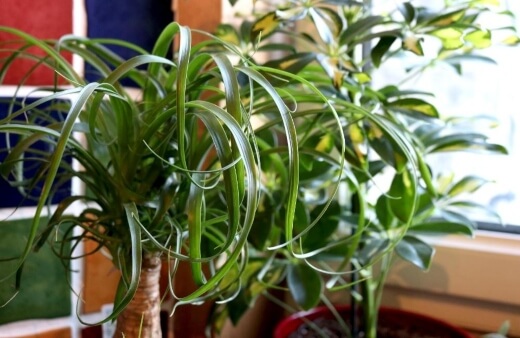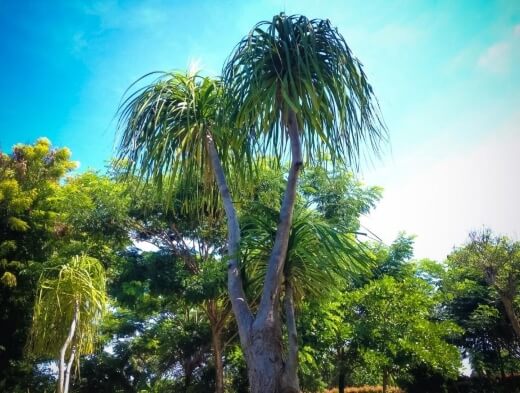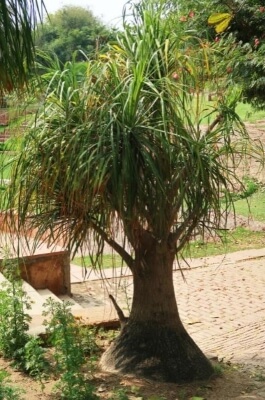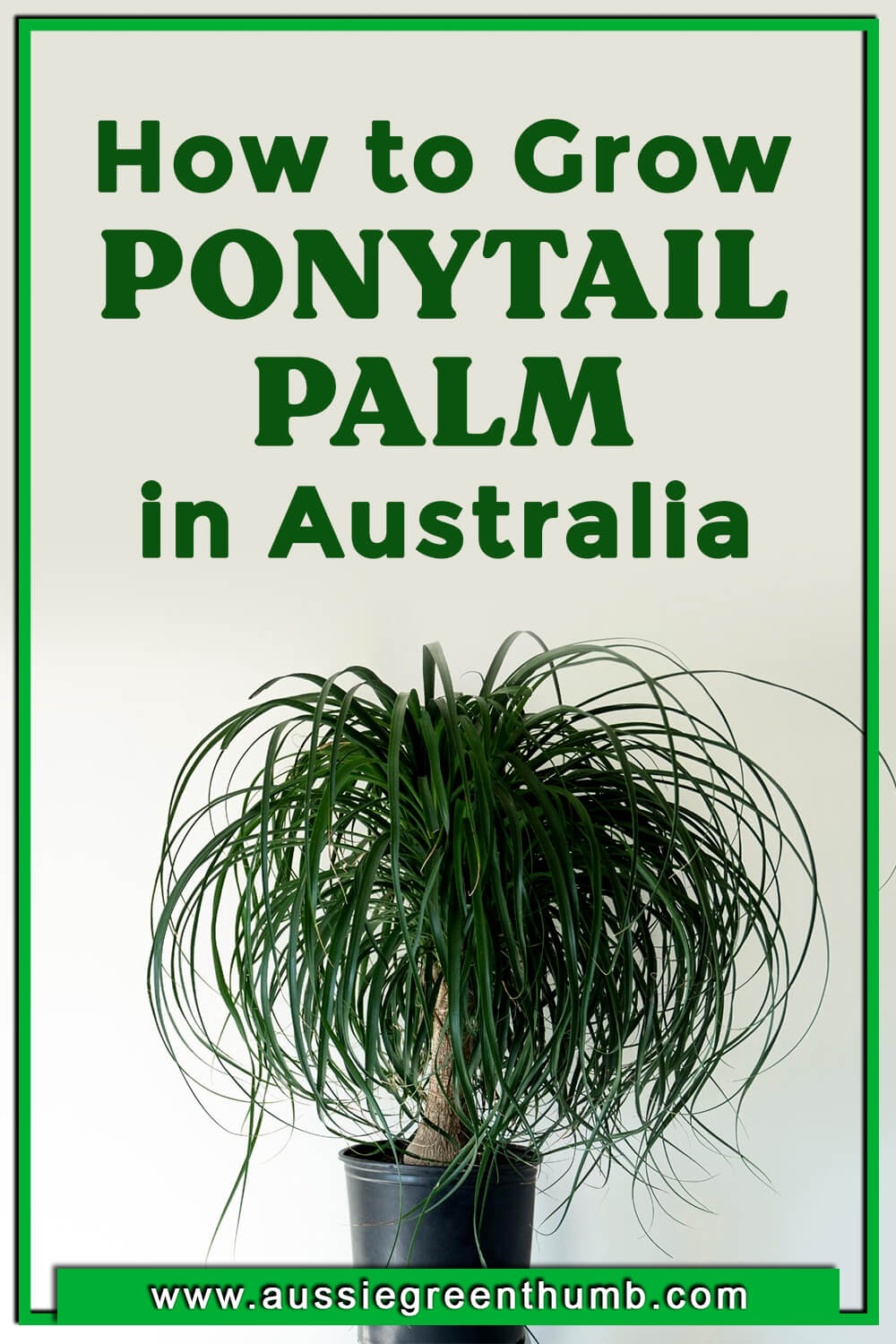If you’ve been looking for a palm-like ornamental tree to establish in your garden or indoors, the ponytail palm is an excellent option for you to consider.
This evergreen perennial has gained popularity worldwide thanks to its decorative features, long-living nature and very low maintenance requirements.
Being perfectly suited to our endemic climates, this stunning strappy-leaved tree can certainly fit into any setting. Here is your full guide to growing and caring for the ponytail palm.
More...
Family: | Asparagaceae |
|---|---|
Genus: | Beaucarnea |
Species: | B. recurvata |
Common Names: | Ponytail palm, elephant’s foot tree |
Location: | Indoor or outdoor |
Type: | Evergreen plant |
Growth: | 9 to 10 metres tall, 3 metres wide outdoors (much smaller indoors) |
Sun Requirements: | Full sun to partial shade |
Foliage Colour: | Green |
Flower Colour: | White |
Flowering: | Summer (once mature) |
Maintenance level: | Low |
Poisonous for pets: | Non-toxic to cats and dogs |
Introducing Ponytail Palm
Featuring a swollen base for water storage with a single trunk that tapers upwards then branches with tufts of long leathery arching leaves, this tree also has a smooth attractive bark.
All these ornamental features make this plant highly sought-after in temperate climates across the globe. Having the ability to live for over 100 years, the ponytail palm does take about 10 years to reach maturity when it will add further spectacle to your spaces with its panicles of small white flowers in the summers.

Botanically called Beaucarnea recurvata, the tree used to also be known as Nolina recurvata and Nolina tuberculata. Common names include ponytail palm and elephant’s foot tree thanks to its large swollen base.
This plant belongs to the Asparagaceae family, sharing many succulent qualities with other members of the family. It was originally native to many states of eastern Mexico but is now confined to the state of Veracruz.
Despite its name, this tree is not closely related to true palms. Naturally thriving in low deciduous forests in temperate climates, this tree is now grown and cultivated in many temperate regions of the world.
It grows really well in most parts of Australia, hence its large presence here. It will however need to be protected from frost in cooler climate zones.
Ponytial Palm Growing Habits
Ponytail palm is a very slow-growing tree that can reach 9 to 10 metres tall and about 3 metres wide outdoors, growing much smaller if planted in containers indoors.
It takes about 10 years for this tree to reach maturity when only then it will begin flowering in summers with clusters of beautiful white blooms.
It is now mostly planted as an ornamental garden tree or grown in containers to be used as a smaller decorative palm-like addition to house plant collections.
Other applications include patio or balcony landscaping, accent specimen in succulent gardens or it is also commonly used as a novelty plant.
How to Grow Ponytail Palm
After flowering, spectacular stems of pinkish 3-winged seeds will form on mature females. These seeds can be collected and used to grow your very own tree but since these plants take so long to reach maturity, this isn’t always very likely.


Get Your Free Guide:
Master Growing Australian Natives eBook
A Must Have Complete Guide for Every Australian Garden
Get Your Free Guide:
Master Growing Australian Natives eBook
A Must Have Complete Guide for Every Australian Garden

Ideal Conditions for Planting Ponytail Palm
It is important to provide your tree with the best conditions possible to allow it to grow as vigorously as possible each year. Healthy plants should grow 30 centimetres each year in the right conditions.
Before selecting your planting site, be sure to account for growth over generations and also consider the bulbous base around paving and other such structures.
Exposure to Sunlight
For outdoor growing, full sun to partial shade is best. For indoor plants, try to provide them with as much bright light and warmth as possible. Indoor plants will always grow slower and smaller than plants established outdoors.
Best Soil for Beaucarnea recurvata
Good drainage is essential for your soil as these plants are susceptible to being overwatered. They also prefer fertile soils so enrich your soil with organic materials or compost before planting.
Add a fresh layer of compost annually to encourage growth. Use a compost bin to make composting easier and more convenient. It is also best practice to loosen your soil before planting.
For indoor growing, use a high-quality cactus potting mix or a similarly loose and well-draining medium like sand and perlite.
Propagating Ponytail Palm
Propagation is also possible by dividing the baby side suckers that develop at the base of parent plants. These suckers, offsets or pups can be divided off and propagated to grow a true-to-type elephant’s foot tree.
Alternatively, healthy young nursery plants are widely available and are easy to transplant and establish in your desired position.

Growing Ponytail Palm from Seeds
- Collect seed capsules once they have turned brown and have dried. This is usually around early autumn.
- Open seed capsules into a clean container or paper towel to collect your seeds.
- Soak the seeds in water overnight or gently nick a part of the seed shell to increase germination speed. These seeds are tough so they need to be softened or the coating needs to be damaged a little to allow the sprout to emerge.
- Prepare 8 cm containers filled with light gritty soil. (Check out these Seed Starter Peat Pots for reference).
- Lightly wet the soil and then sow your seeds into the surface of the mixture, gently pressing them into the soil, not too deep.
- Add a light sprinkle of sand on top.
- Keep the soil moist by misting it when needed and place the seeds in a location with temperatures around 20°C with bright light. Shelter seeds from the harsh sun during noon.
- Cover your containers with some plastic wrap until germination to speed things up. Remove the plastic once a day to allow excess moisture to escape.
- Expect sprouting within 1 to 3 months depending on conditions.
- Remove the plastic once you see sprouts.
- Leave the seedlings to develop for some time before disturbing them in any way. Mist when needed and keep them in a warm, bright location.
Propagating Ponytail Palm Using Division
- Divide your ponytail palm shoots in spring.
- Carefully dig around the base of the parent plant to expose the base of the pups.
- Using a clean, sharp knife or pruning shears, cut the small shoots away from the base.
- Your shoots should be at least 10cm tall to ensure they form roots and develop from a good start.
- Use a soilless medium like a cactus potting mix, sand-based potting soil or perlite and fill well-draining containers.
- Place the rooted end of the pups in your moistened medium and cover with plastic.
- Place your container in a warm location in the house with moderate levels of light.
- Every couple of days you can uncover the containers and mist the surface of your mix.
- Water lightly only every 2 to 3 weeks and completely cut out watering in winter.
- As the divided shoots develop, cut away any damaged foliage and repot as needed about every 2 to 3 years.
- The ideal temperatures for these plants to grow is 21 to 27°C.
Caring for Ponytail Palm
These trees are very hardy, being resistant up to -5°C and very tolerant to drought. But some extra care can certainly go a long way in ensuring your tree stays healthy and disease-free. Here are some quick care tips.

Watering Requirements
Water established trees moderately in summer and sparingly in winter. Water only when the surface of the soil is dry to avoid overwatering.
Pruning Ponytail Palm
Prune in early spring to maintain its original shape by snipping away the ends of any damaged or browning leaves. These trees don’t require any hard pruning.
Fertilising Routine
It is recommended to fertilise your tree twice per year to encourage healthy growth. Try not to use any excessive fertilisers and rather use small amounts each time. A good option would be a balanced 10-10-10 slow-release fertiliser applied at half strength twice a year.
Repotting
Because of this tree’s large bulbous base, it will need to be repotted into slightly larger containers every month to two months once established. Repot before the swollen base cracks the current container.
It is best to repot in early spring to summer and be sure to keep all the roots each time you place your plant in a new pot. Water well after repotting.
Possible Beaucarnea recurvata Pests & Diseases
Most of the problems these trees can face stem from overwatering. Soil that is too wet and moist will create perfect conditions for pests like mealybugs, spider mites and cochineal insects. Overwatering can also quickly lead to root rotting diseases.
Root Rot
Root rot will become evident if the fronds of your tree begin to droop. Other signs include browning or black roots accompanied by an unpleasant musty smell.
As soon as you notice any signs of root rot, immediately stop watering altogether and your plant should be able to bounce back in time.
Mealybugs/Spider Mites/ Cochineal Insects
These pests can rarely cause severe damage to these hardy trees but they will need to be removed to keep your plant looking healthy and in good form.
To get rid of these infestations, use a soft sponge and a water and soap combination to gently rub the stem and leaves to detach the insects.
Repeat this every couple of weeks to free your plant of any pests moving forward. Alternatively, use a quality neem oil.
Ponytail Palm Frequently Asked Questions

Source: gardenerspath.com
Do ponytail palms have invasive roots?
Despite their large bulbous bases, these trees like many other succulent and cacti-type plants don’t have invasive roots. The root systems are shallow and shouldn’t disturb nearby structures or buildings.
Why are the leaves of my ponytail palm turning yellow?
Yellowing leaves are a clear indication that you are overwatering your tree or that there is an over-application of fertiliser.
What does an underwatered ponytail palm look like?
The leaves will look droopier and more wilted than usual. The leaves will normally be recurved, meaning they turn downwards, but under watered plants will show leaves that hang lower than usual.
If you’re interested in also growing gorgeous true palms in your garden or home, we’ve got a few other helpful guides for you to check out:
Indoor Palms
Outdoor Palms

Plump Up Your Garden or Living Spaces with the Ponytail Palm
This exotic palm-like tree makes for a perfect long-living ornamental addition to gardens but it is also ideal for smaller indoor potted scenarios.
Either way you choose to showcase your elephant’s foot tree, it’s bound to impress with its attractive form, luscious leathery arching leaves and once mature, panicles of delicate small white blooms.
Being so accessible to any grower regardless of skill, it’s easy to see why the ponytail palm has become such a sought-after addition to so many homes throughout Australia.
Published on July 16, 2022 by Maisie Blevins
Last Updated on September 20, 2025





hi I'm sorry I'm beside myself as my dear indoor ponytail plant wasn't looking too well and when I gently stroked the young centre leaves they came straight out as one small bunch in my hand. They are joined and the remaining leaves are still strong and green looking. can I save any part of my plant. I am now, after reading your text, sure I've over watered the dear soul?Hope you can advise me. Thanks for your time Julie Heath, Central Coast NSW Australia
Hi Julie,
You can save them. I’ve bought a couple of ponytail palms that were on their last legs from the reduce sections of garden centres, and it’s amazing what they can recover from. That being said, it’s unlikely you’ll get a single straight stem again.
If you dry the root ball out completely, that’s the first place to start. It’ll stress the plant, and if you’re lucky it’ll have a stress response where a small point at the base of the trunk should start to swell.
This is a new stem forming. Once you see that, leave it to develop and give the plant a good drink in a bright spot where the moisture can either evaporate or drain.
After a few weeks, the swollen point should sprout, and then you can be confident in cutting off the entirety of the old top.
Its drastic but it works. We’ve done this a few times with ponytail palms and various Dracaenas.
Good luck!
Massie Blevins